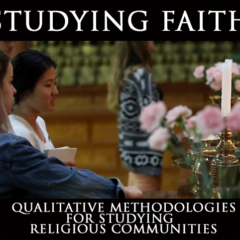Qualitative sociology and anthropology are similar to journalism, but there are some key differences. The time a social scientist spends collecting data is usually much longer than a journalist. One of the reasons social scientists are able to spend so much time collecting data is that the research is not tied to the news cycle and the emphasis is on the analysis, not an up-to-date description of the event, place or group of people.
News stories offer some facts or data about a topic, and journalists can bring in greater context through in-depth features. The detailed process of a sociological or anthropological examination can offer insights and understandings of religious groups or phenomena that the journalistic reporting process may not uncover. Journalists, therefore, often seek out the expertise of scholars who have studied a topic extensively.
Additionally, the publications produced by social scientists are directed at other academics, so the structure, vocabulary, writing style and length of the books and articles they write will be much different from those written by journalists, who write for the general public.
How is social science and journalism different?
In this video, journalist Nick Street explores some of the differences between how a social scientist and a journalist go about making sense of their observations and interviews.
What can journalists and social science researchers learn from each other?
As part of a hybrid journalistic-academic project, the Center for Religion and Civic Culture commissioned 80 projects on spiritually engaged humanitarians from journalists, along with two dozen academic case studies. CRCC journalism fellow Ken Chitwood, who also has a PhD in the ethnographic study of religion, produced a report on “Ethnographic Religion Reporting” for ReligionLink based on his work on five profiles and interviews and focus groups with other journalism fellows.
Ethnography has long played a critical role in the study of religion, complementing more textual and historical approaches to religious practice and communities and local forms of religiosity.
Moving away from idealized or ideological representations of “religion,” the ethnographic study of religion offers a nuanced, textured and “messy” snapshot of socio-cultural diversification in religious expression, practice, and material life and ways that actors adapt their beliefs, practices, rituals etc. to specific contexts and circumstances….
With that said, ethnographers have long struggled with communicating their critical findings to the general public. In this regard, they can both learn from — and lean into active collaborations with — religion newswriters, whose raison d’être is communicating to a wide array of audiences.
And this is the point of ethnographic journalism. It is not to make ethnographers out of journalists or journalists out of ethnographers. Instead, it is an invitation for each to learn from the experience of the other in order to improve the methods and aesthetics of their own practice, for the sake of the improved public understanding of religion.
Read the “Ethnographic Religion Reporting” guide
Nalika Gajaweera was a senior research analyst with the USC Center for Religion and Civic Culture through 2023.
Andrew Johnson is a contributing fellow with the USC Center for Religion and Civic Culture.

